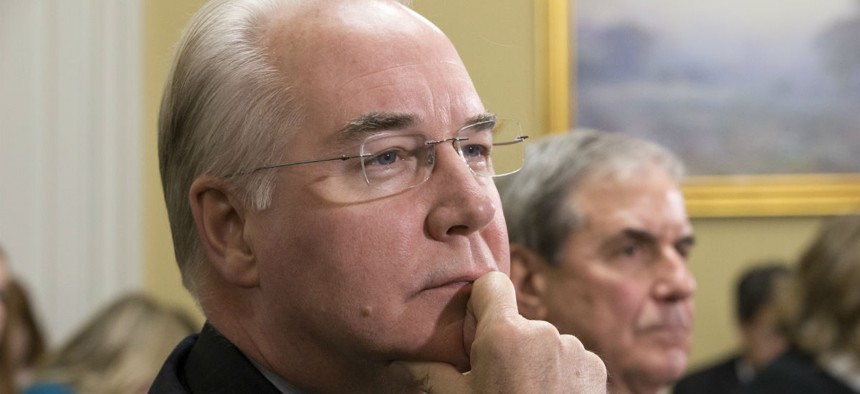
Rep. Tom Price, R-Ga., chairman of the House Budget Committee J. Scott Applewhite/AP
House GOP Budget Plans Face a Minefield
Disputes over mandatory programs and defense spending are complicating Republican leaders’ efforts to bring their own members on board.
House Republican leaders unveiled their budget outline Thursday morning, but deep divisions remain in the conference about how much the plan spends, whether the chamber can offset funding, and where defense money comes from.
Leaders spent Thursday afternoon testing the temperature of their proposal in the GOP Conference, but so far, sources said the plan was not gaining enough support to pass. Leaders will revisit the issue after the recess week, but if there is no movement, they have said they will pass a yearlong continuing resolution and move on.
At a private conference meeting, House Budget Committee Chairman Tom Price unveiled the plan, which sticks to the $1.07 trillion outline agreed to in October and promises to balance within 10 years while allowing a vote on a separate measure offsetting $30 billion in spending with mandatory cuts over a two-year window.
The specifics of those cuts have yet to be outlined. As a result, some House conservatives immediately decried the proposal, noting they would not vote for a $1.07 trillion budget unless $30 billion in cuts comes in fiscal 2017—and they want leadership to lay out a plan to force them into law, rather than allowing the Senate or the president to block them.
Republican Study Committee Chairman Bill Flores said Price made a “good start” by proposing the cuts over two years, but that he needs to see where the cuts are, what the reforms are, and how they put them in place.
“I think Tom has moved a long way toward what we need to do. We still need to help get him the rest of the way,” Flores said.
Others were less forgiving.
“I still don’t think it goes far enough,” said Rep. Andy Harris, an appropriator and member of the House Freedom Caucus. “I lean ‘no’ on it. I think we have to have real offsets.”
To try to make that possible, some members are looking to a proposal that Harris has advocated and that Rep. Tom McClintock put onto paper and outlined at Thursday’s meeting. McClintock’s plan calls for House rules changes to allow mandatory spending to be amended in appropriations bills and forbid mandatory spending expansions in the same way the House forbids earmarks.
But whether leadership would go along with such a plan remains unclear. Stripping jurisdiction from some committees mid-session to give more power to the Appropriations Committee would surely cause waves among committee chairs, and perhaps even conservatives wary of giving appropriators more power. And leadership staff on Thursday were examining the scope of an all-out ban on mandatory spending expansions and what practical effects that would have on policy.
Still, if conservatives haven’t found enough reasons to vote against the budget, another is lurking in the form of off-budget money used to fight the war on terror, also known as the Overseas Contingency Operations fund. The issue almost derailed the process last year when defense hawks and members who wanted spending cuts could not agree how much to allocate for defense.
House Armed Services Committee Chairman Mac Thornberry said Thursday the budget plan would allow the Department of Defense to use $23 billion of the OCO funds, effectively raising the Pentagon’s base budget from $551 billion to $574 billion.
“While I do not think that is nearly enough money for defense, that was the agreement, and I am for sticking with the agreement,” he said.
Thornberry said there are ongoing discussions about plussing up OCO even more to account for programs President Obama proposed, including keeping service members in Afghanistan, doing more against ISIS, and showing support for Eastern European allies wary of Russia’s incursion into the region.
“I think there are still discussions going on about the OCO part of the budget and how we deal with a president who has proposed all these activities but hasn’t proposed the money,” Thornberry said.
The problem is the money is not included in the budget’s topline $1.07 trillion price tag, which has in the past drawn rebukes from members who are concerned about spending and think OCO is a gimmick.
Still, Price said that even if the conference cannot unify around a budget, deeming a budget is not an option he wants to pursue. “I don’t think that’s a viable option,” he said. “I don’t think it’s productive in unifying the conference.”
Speaker Paul Ryan, for his part, reiterated that he will not push the budget plan on members any more than he already has. Ryan said he wants to pass a budget, but has said if members do not want to pass one, they do not have to.
“Ultimately this is going to be a decision made by our team. That’s what I laid out to our conference this morning,” Ryan said. “I fundamentally believe that we need to pass a budget and we need to have a full functioning appropriations process, and I laid that out to the members.”







